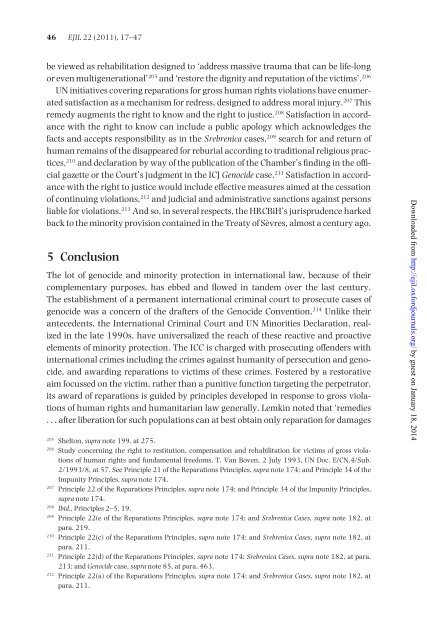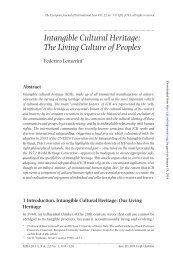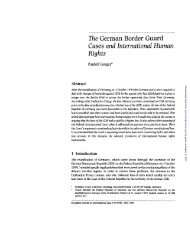Genocide and Restitution - European Journal of International Law
Genocide and Restitution - European Journal of International Law
Genocide and Restitution - European Journal of International Law
You also want an ePaper? Increase the reach of your titles
YUMPU automatically turns print PDFs into web optimized ePapers that Google loves.
46 EJIL 22 (2011), 17–47<br />
be viewed as rehabilitation designed to ‘address massive trauma that can be life-long<br />
or even multigenerational’ 205 <strong>and</strong> ‘restore the dignity <strong>and</strong> reputation <strong>of</strong> the victims’. 206<br />
UN initiatives covering reparations for gross human rights violations have enumerated<br />
satisfaction as a mechanism for redress, designed to address moral injury. 207 This<br />
remedy augments the right to know <strong>and</strong> the right to justice. 208 Satisfaction in accordance<br />
with the right to know can include a public apology which acknowledges the<br />
facts <strong>and</strong> accepts responsibility as in the Srebrenica cases, 209 search for <strong>and</strong> return <strong>of</strong><br />
human remains <strong>of</strong> the disappeared for reburial according to traditional religious practices,<br />
210 <strong>and</strong> declaration by way <strong>of</strong> the publication <strong>of</strong> the Chamber’s finding in the <strong>of</strong>ficial<br />
gazette or the Court’s judgment in the ICJ <strong>Genocide</strong> case. 211 Satisfaction in accordance<br />
with the right to justice would include effective measures aimed at the cessation<br />
<strong>of</strong> continuing violations, 212 <strong>and</strong> judicial <strong>and</strong> administrative sanctions against persons<br />
liable for violations. 213 And so, in several respects, the HRCBiH’s jurisprudence harked<br />
back to the minority provision contained in the Treaty <strong>of</strong> Sèvres, almost a century ago.<br />
5 Conclusion<br />
The lot <strong>of</strong> genocide <strong>and</strong> minority protection in international law, because <strong>of</strong> their<br />
complementary purposes, has ebbed <strong>and</strong> flowed in t<strong>and</strong>em over the last century.<br />
The establishment <strong>of</strong> a permanent international criminal court to prosecute cases <strong>of</strong><br />
genocide was a concern <strong>of</strong> the drafters <strong>of</strong> the <strong>Genocide</strong> Convention. 214 Unlike their<br />
antecedents, the <strong>International</strong> Criminal Court <strong>and</strong> UN Minorities Declaration, realized<br />
in the late 1990s, have universalized the reach <strong>of</strong> these reactive <strong>and</strong> proactive<br />
elements <strong>of</strong> minority protection. The ICC is charged with prosecuting <strong>of</strong>fenders with<br />
international crimes including the crimes against humanity <strong>of</strong> persecution <strong>and</strong> genocide,<br />
<strong>and</strong> awarding reparations to victims <strong>of</strong> these crimes. Fostered by a restorative<br />
aim focussed on the victim, rather than a punitive function targeting the perpetrator,<br />
its award <strong>of</strong> reparations is guided by principles developed in response to gross violations<br />
<strong>of</strong> human rights <strong>and</strong> humanitarian law generally. Lemkin noted that ‘remedies<br />
. . . after liberation for such populations can at best obtain only reparation for damages<br />
205<br />
Shelton, supra note 199, at 275.<br />
206<br />
Study concerning the right to restitution, compensation <strong>and</strong> rehabilitation for victims <strong>of</strong> gross violations<br />
<strong>of</strong> human rights <strong>and</strong> fundamental freedoms, T. Van Boven, 2 July 1993, UN Doc. E/CN.4/Sub.<br />
2/1993/8, at 57. See Principle 21 <strong>of</strong> the Reparations Principles, supra note 174; <strong>and</strong> Principle 34 <strong>of</strong> the<br />
Impunity Principles, supra note 174.<br />
207<br />
Principle 22 <strong>of</strong> the Reparations Principles, supra note 174; <strong>and</strong> Principle 34 <strong>of</strong> the Impunity Principles,<br />
supra note 174.<br />
208<br />
Ibid., Principles 2–5, 19.<br />
209<br />
Principle 22(e <strong>of</strong> the Reparations Principles, supra note 174; <strong>and</strong> Srebrenica Cases, supra note 182, at<br />
para. 219.<br />
210<br />
Principle 22(c) <strong>of</strong> the Reparations Principles, supra note 174; <strong>and</strong> Srebrenica Cases, supra note 182, at<br />
para. 211.<br />
211<br />
Principle 22(d) <strong>of</strong> the Reparations Principles, supra note 174; Srebrenica Cases, supra note 182, at para.<br />
213; <strong>and</strong> <strong>Genocide</strong> case, supra note 85, at para. 463.<br />
212<br />
Principle 22(a) <strong>of</strong> the Reparations Principles, supra note 174; <strong>and</strong> Srebrenica Cases, supra note 182, at<br />
para. 211.<br />
Downloaded from http://ejil.oxfordjournals.org/ by guest on January 18, 2014








